Higher Frequencies and Miniaturization Result in New Coax Connectors
As communications applications approach THz frequencies, current 5G and future 6G introduce new RF connectors.
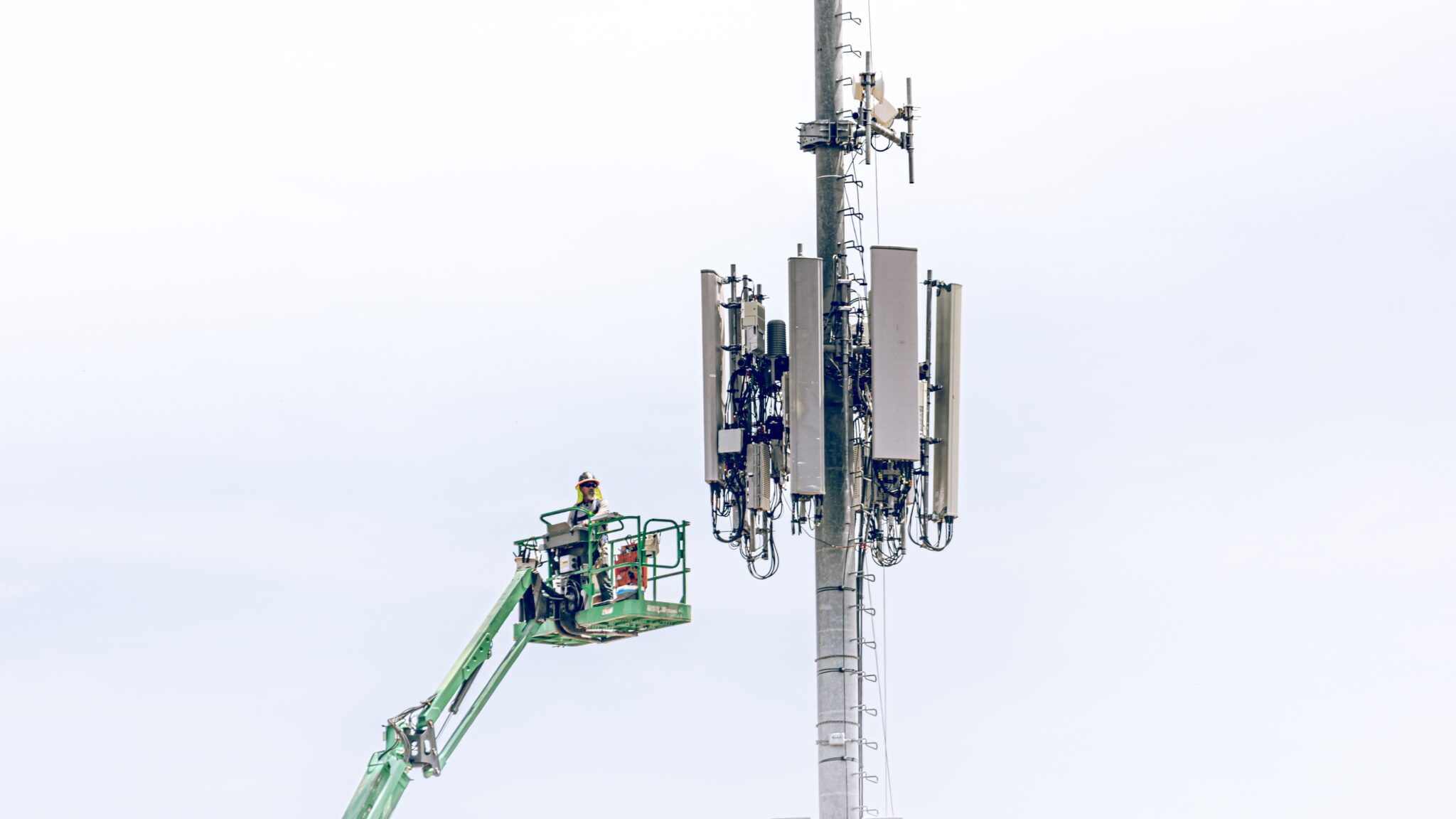
Trends for miniaturization, higher frequency, and more RF power push connector suppliers to optimize designs and develop new products to meet industry needs. Most RF coaxial connectors can be used in many different end-use applications and markets. For example, the same 2.92 mm connector could be used in medical MRIs and satellites plus radios and test equipment, while the new E-band 1.35 mm connectors are suitable for 5G backhaul systems, test systems including VNAs, and self-driving vehicles. Expectations for 6G and the high speeds needed for chip testing have moved connectors into frequencies previously served only by waveguides.
The RF coax connector portion of total connector sales is becoming increasingly important as the number of fixed communications and wireless enabled devices and the amount of data consumed grows at an almost unfathomable rate. The global growth forecast by CCD Insight is for over 2.7 billion 5G connections by 2025. The COVID-19 pandemic has slowed the standardization work to enable availability of 5G for large enterprise implementations and to expand capacity while pushing for faster implementation of 5G and associated IoT communications to help speed recovery and assure growth.
The most popular 5G frequencies will be in the mid-band ranges (2.1 to 2.6 GHz and 3.3-3.8 GHz) for local service, while many 5G ultra-wideband networks will use 28 GHz and 39 GHz mmWave spectrum bands. 5G communications also will take advantage of the recently redefined E-Band for backhaul transmission prompting new E-series connectors for DC to 92 GHz, while also expanding sales for lower frequency, low PIM, and standard connectors such as 7/16, N, NEX10, etc. 5G and IoT mobile devices will expand demand for automated production (and automated pick-and-place installation) of micro-miniatures such as U.FL, X.FL, MHF, PCIe, and miniatures such as MMCX and SMB, primarily for operation under 6 GHz.
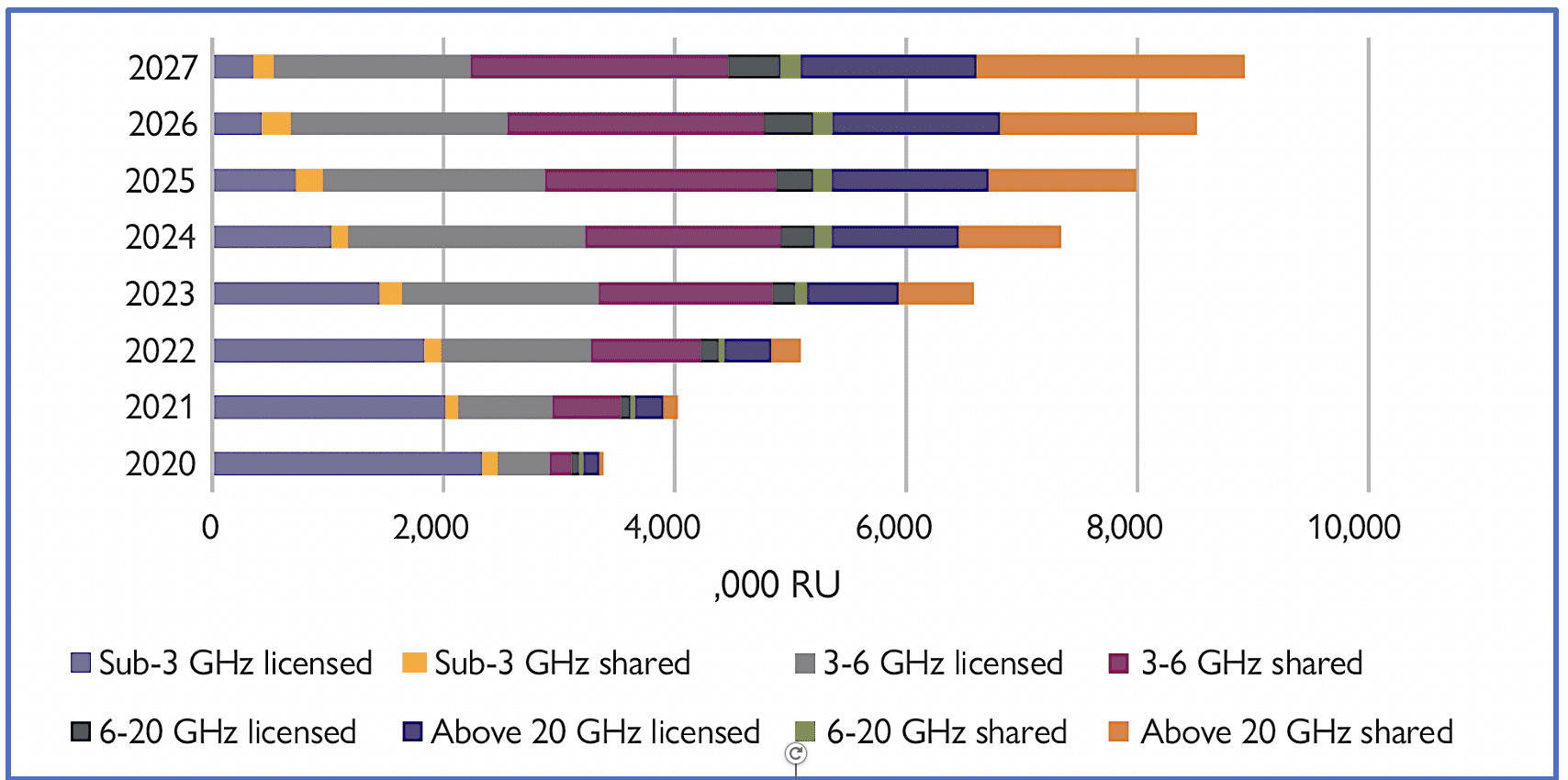
Primary Frequency Bands: Projections for new deployments and upgrades of small cells for 2020-2027F. Source: Small Cell Forum forecast report, July 2022
R&D/prototyping underway for future 6G has resulted in new equipment for high-GHz frequencies, often referred to as sub-Terahertz (THz), which have frequencies extending from 0.1 THz up to 10 THz, with wavelengths between 3 mm and 30 μm. The prospect of offering wide contiguous frequency bands to meet demand for extremely high data transfer rates in the Tb/s range is making this region a key research area for next generation wireless communications. This has pushed new connector development, especially for test equipment such as Anritsu’s new 70 kHz to 220 GHz broadband network analysis system that uses 0.6 mm flanged test-port connectors for frequencies to 220 GHz, well above the prior top-level of 145 GHz provided by 0.8 mm connectors. To help expand supplier sourcing, Anritsu has made selected design information public. (Anritsu information on connectors for 220 GHz application is from Anritsu Technical Bulletin No. 95.)
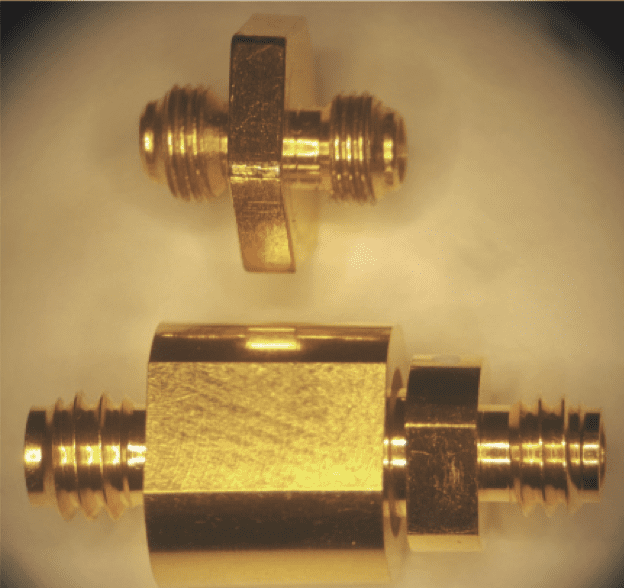
Above, length comparison between Anritsu 0.8 mm Fe-Fe adapter (top) to their 1 mm Fe-Fe adapter. The 1 mm is offered for 110 GHz applications. (Author’s comment: Keysight Technologies offers an “optimized 1 mm” for 125 GHz, but currently does not use 0.8 or 0.6 mm connectors for test ports.)
Trends will continue for smaller and more miniaturized packaging, supported by higher speed chips and multi-frequency receive/transmit capability. The shorter wavelengths of higher frequencies enable further miniaturization of antenna arrays. Many coax connector suppliers, such as Molex and TE Connectivity, now offer connectorized sensor packages with cable options. Higher densities resulting from miniaturization add to potential ESD sensitivity and new higher-breakdown materials can be expected, which may increase shielding and RF leakage requirements. New test and communications board assemblies will increase use of compression-mounted coax jacks.
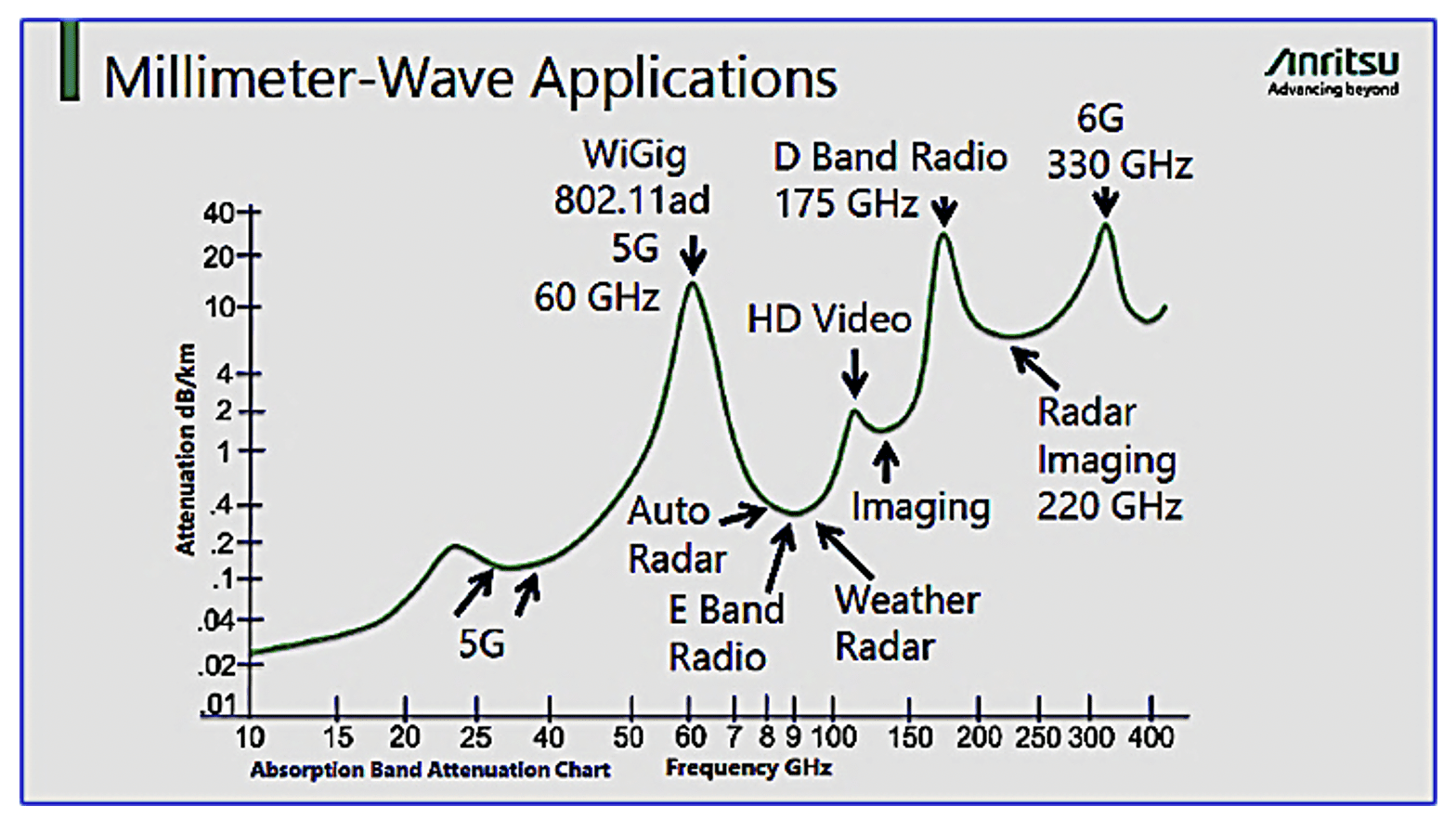
Better performance is important, as stated by Mark Waring, senior technical marketing specialist at Hirose Electric. “We [Hirose] are focused on incremental extension of both SI and environmental performance for mmWave test-port solutions, with a focus on both extending SI, particularly VSWR, performance ranges, and at the same time pushing temperature performance.”
Multiport Assemblies
The use of multiport assemblies is growing for military and aerospace applications due to weight savings and reliability benefits. Many sources offer coax assemblies for installation in standard contact cavities of Series III MIL-DTL-38999 connectors. Southwest Microwave offers several versions of miniature coax for Size 20 cavities for up to 110 GHz applications depending upon the cable used.

At right, Size 16, 12, and 8 coax assemblies are offered loose and assembled into
connectors by SV Microwave (Amphenol).
For 5G antenna installations and other communications equipment, the Next Generation Mobile Network (NGMN) recently standardized the MQ4/MQ5 cluster multiport connectors. They were originally proposed by Huawei Technologies, a company blocked by U.S. import restrictions. However, by late 2022, market potentials prompted MQ4/MQ5 to be offered by other sources including HUBER+SUHNER, Spinner, and Rosenberger.

MQ4/MQ5 cluster multiport connectors by HUBER+SUHNER
MOSA and VITA Standards
Additional coax connector sales will be generated by a relatively new industry standard called Sensor Open Systems Architecture (SOSA) that is becoming popular for data processing and sensor platforms. Based upon a subset of OpenVPX, SOSA standards define a standardized approach for aerospace and defense applications. SOSA falls within a group of emerging standards called Modular Open Systems Approach (MOSA). Terms used, besides SOSA, include Future Airborne Capability Environment (FACE), Vehicular Integration for C4ISR/EW Interoperability (VICTORY), and Open Mission Systems/Universal Command and Control Interface (OMS/UCI). Usage is relatively assured as the U.S. Department of Defense has mandated adoption of MOSA concepts for procurement across all services. The goal is to enable cross functionality and interchangeability of equivalent multi-sourced equipment between the Air Force, Navy, Army, and Marines.

Examples of Modular VITA-specified Coax Assemblies for SOSA Open Architecture Systems (TE Connectivity)
Military bases are installing 5G capabilities for both systemic and cyber-security benefits. Battlefield scenarios will involve IoT, AI, and all features of advanced microwave technology. Radar and satellite systems will use the same or adjacent frequency bands. Most coax connectors will be COTS or equivalents per SCDs or DSCC drawings where applicable, as MIL-QPLs currently do not cover many coax connectors operating above SMA-levels.
Waveguides and Coax Connectors Overlap
As connector performance moves into higher-GHz (sub-THz) frequencies, they become applicable where previously only waveguides could be used. Waveguides (WGs) are still preferrable when higher power is needed. An important difference is that coax connectors operate from DC to maximum frequency, while waveguides have a min-max band. The frequency range for waveguide-to-coax adapters is based upon both the WG and connectors used. Similar to between-series connector adapters, the connector‘s maximum frequency must be within the range of the waveguide and usually is the upper-operating limiting factor. Results are illustrated below for WG-to-Coax adapters using 1 mm connectors with different WGs.
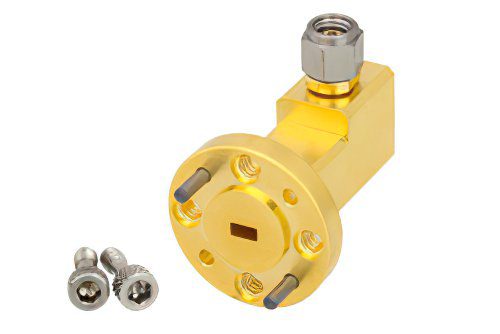
1 mm coax connector with WR-12 WG, for 60 to 90 GHz. (Pasternack)
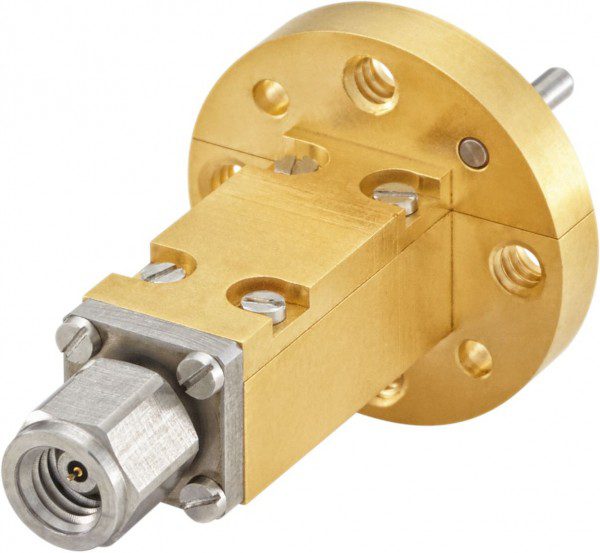
Rosenberger waveguide adapter with 1 mm coax and WR-10 WG for 75-110 GHz
Advanced performance test equipment usually uses ruggedized, precision NMD (named for Hewlett-Packard’s past Network Measurement Division) test interface chassis connectors. Higher frequencies will involve WG equivalents.
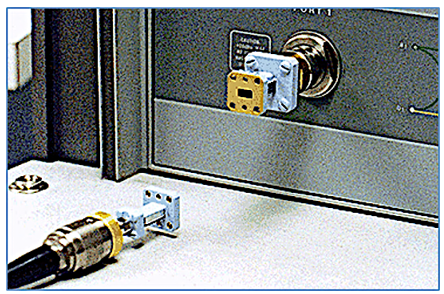
Maury Test Port Adapters on an Anritsu 3611 Test Set.
Miniaturization Trends
Miniaturization is an ongoing objective, enabled by the performance offered by shorter wavelengths at higher frequencies and the need to reduce equipment size to fit smaller packaging from board-size to mini-Small Cells to fit under streetlights, within business signs (e.g., McDonalds’ arches), and crowded buildings. They also are used for wireless LAN antennas and Bluetooth applications in mobile phones, GPS, wireless communication devices, notebook computers, access and test points, and gaming equipment, among other applications. Especially important is that many of these unique coax connectors are becoming mullti-sourced.
Hirose’s U.FL cable-to-board with mounted height of just 1.9 mm (0.074 inches) covers the primary 5G frequencies to 8 GHz, with equivalent sourcing by IPEX (MHF series), plus Samtec and Johnson (Cinch). IPEX’s MHF4 has a mated height of 1.2 mm (0.047 in.) while Hirose’s W.FL has 1.4 mm (0.055 in.) but is not recommended for new design.
Not many types of miniature board-to-board coax connectors are industry-standardized and multi-sourced. Exceptions include the SMP3/SMPS/G3PO and its larger version SMPM/GPPO, which were originally provided by Gilbert Engineering (now Corning Gilbert, part of Corning Optical Communications RF LLC). These are three-piece stack-ups using an intermediate “bullet” between receptacles. These connectors were documented to have electrical intermateability problems between suppliers. Conflicts were resolved when DLA/DSCC published performance specifications and interface dimensions in April 2022 for the SMP3 connectors with plans to include them in MIL-STD-348. The larger (but still “tiny”) SMPM was added to MIL-STD-348 as figures 328-1, -2, and -3.

New Standards Continue to be Released
Precision metrology-grade test connectors are covered by IEEE Standard 287. The latest revision is IEEE 287-2021, published September 2022.
A revision to the primary specification for RF coax cable, now MIL-DTL-17J incorporating latest amendments dated 2 November 2022, was released by DLA/DSCC on December 10, 2022.
For new waveguides, the IEEE has established a working group (IEEE Standard P3136) for defining a “Universal Waveguide Interface for 60 GHz and Above.” Its international kickoff meeting was June 22, 2022, with its first working meeting held on January 25, 2023.
Most coax connectors use dust caps, shorting caps, or other protective covers. These are defined by MIL-PRF-39012/25F, which was released by DLA /DSCC for use on January 13, 2023.
 Some of the content for this article was derived from the new Market Research Report, “World RF Coax Connector Market 2023,” published January 2023 by Bishop & Associates Inc.
Some of the content for this article was derived from the new Market Research Report, “World RF Coax Connector Market 2023,” published January 2023 by Bishop & Associates Inc.
To learn more about the companies mentioned in this article, visit the Preferred Supplier pages for Bel Magnetic Solutions, Hirose Electric, I-PEX, Molex, Samtec Inc., SV Microwave, and TE Connectivity
Like this article? Check out our other RF and Coax articles, our Datacom Market Page, and our 2022 and 2023 Article Archives.
Subscribe to our weekly e-newsletters, follow us on LinkedIn, Twitter, and Facebook, and check out our eBook archives for more applicable, expert-informed connectivity content.
- New Circular Connectors Add to Multi-Billion Dollar Market - January 9, 2024
- Counterfeit Components Ground Airlines - December 12, 2023
- Cables, Connectors, Waveguides, and Hybrid Products for up to THz at IMS 2023 - July 11, 2023

